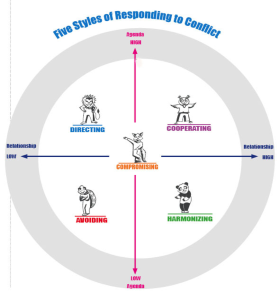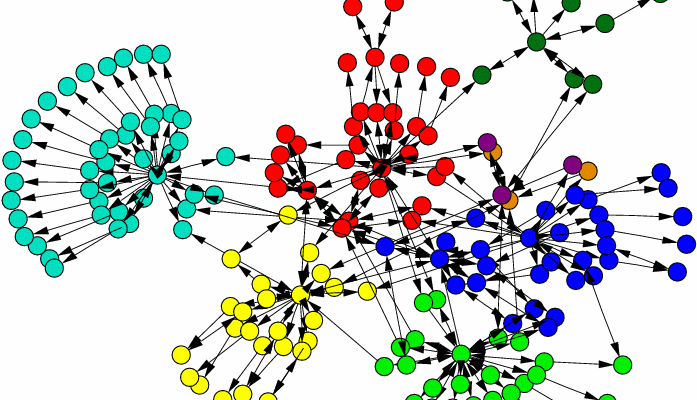“You cannot direct a living system; you can only disturb it”1
When mediators join a conflict, they enter a living system. Realise it or not, that system is instantly changed by their arrival. Change may be for the better, and we hope our influence is benign, but nothing is the same again. It therefore makes sense for those intervening in other people’s conflict to know themselves: what kind of person is joining the system?
When teaching new mediators I like to use Ron Kraybill’s “Stylematters” Conflict Style Inventory. Based on Mouton and Blake’s managerial grid, it provides a speedy snapshot of individuals’ approach to conflict based on two axes: concern for relationships (horizontal) and concern for agenda (vertical). High concern for agenda combined with low concern for relationships is the “Directing” style; high concern for relationships and low for agenda is the “Harmonizing” style; the “Avoiding” style appears little concerned with either; “Cooperating” involves attending to relationships AND agenda; while the “Compromising” style, as the name suggests, is somewhat concerned with both.

Once of the reasons I like Kraybill’s resource is his determination not to make anyone feel bad about their preferred conflict style. All have their strong points: “We are most successful in conflict when we are flexible in our abilities and can use each of the five styles skilfully as needed”2. Nonetheless most of us tend to use one or two styles. One of the most valuable insights from taking the survey is a rough view of our own default style. Each style has its strengths. For example, the Directing style – “speed, decisiveness… useful in emergencies”; harmonizing – “flexible and easy to work with”; avoiding – “freedom from entanglement in trivial issues”; compromising – “enables the show to go on”; and cooperating – “trust and mutuality”. But they all have their costs too – it won’t surprise readers that the Directing style may lead to “inequality, resentment, reduction in trust…”, or the Harmonizing to “frustration for others”.3
I’d recommend that anyone take the inventory (see www.riverhouseepress.com); but for prospective mediators it has a particular value. If we dare to become involved in other people’s conflict we should know what kind of style we bring with us. Recent work with law students got me thinking: what are the particular benefits and drawbacks of each style for mediators? So, with a big acknowledgement to Ron Kraybill, here’s a rough list:
Harmonizing: your natural concern for others will probably help you build trust and protect you from offending a client; it will fuel your curiosity about their lives and lead to good questions; the conversation’s unlikely to dry up. However, you may find it difficult to voice challenging or critical thoughts; you know how to make people feel happy, but that may not be what they need – your warmth and empathy may inadvertently reinforce people’s fixed positions, leading to impasse. The challenge: work on saying difficult things when instinct tells you someone won’t like it.
Directing: your concern to get the thing done will probably bring intense energy and persistence to the search for resolution; you’ll probably see openings where others don’t and move quickly and efficiently towards them. However, your biggest risk is “pissing people off” (my words!) You may also be tempted to take shortcuts and avoid the lengthy and tiresome business of helping people find their own solutions. The challenge: work on keeping your thoughts to yourself and waiting to see what emerges from the parties.
Avoiding: your calmness and refusal to rise to the bait will probably create a good atmosphere for problem-solving; by ignoring provocation you can help people work out what is truly important; and your tendency to back off will create space for the parties to do the work. However, you may experience an overwhelming temptation to avoid difficult stuff; and too much calmness and silence can come over as a lack of energy. The challenge: work on staying with topics that are fraught or embarrassing; and if you think something without saying it, write it down and bring it up later – it may well contain important insight.
Cooperating: your instinct to keep everyone on board while still reaching for the goal sounds ideal in a mediator; you probably like seeing others flourish and are skilled at building trust; you may also be pretty thorough. However, this style isn’t fast; sometimes it’s better to ‘cut to the chase’ and find the least worst solution; and this approach takes a lot of skill and patience – even if you have it, others may not. The challenge: pick your battles; let the parties tell you when they’ve had enough and just want a deal.
Compromising: your pragmatism and sense of fairness will serve you well in conflict; you may see the potential for deals and trades where others see only problems; and a relatively short attention span can promote efficiency. However, there is a risk that a compromise will leave nobody happy; and some mediation parties may want the conversation as much as the outcome. The challenge: be patient and thorough; keeping checking that you have covered what’s really important to people.
All of this highlights an important learning point for me: there are lots of right ways of being a mediator. Each style could be ideal. One of Kraybill’s central ideas is conflict fluency. He suggests practising our least favourite style so as to develop confidence and the capacity to choose how to respond. Parties and representatives often mention flexibility as a key quality for mediators – so learning how to adapt our style is useful. Much of this will come down to trial and error. If my default is the Cooperating style and after an hour things are going nowhere it makes sense to try one of the others. Kressel’s observation that mediators could switch from a “deep problem solving” to a “tactical problem solving”4 script may be a glimpse of such a move, perhaps from Cooperating to Compromising.
With practice we can become more adept at using the full range of styles. As a system conflict is often vibrant and rarely predictable. The more options you have the better. I leave the last words to Ron Kraybill: “No matter how aware or skillful you are, you will still get hurt or fail sometimes.”5
________________________
To make sure you do not miss out on regular updates from the Kluwer Mediation Blog, please subscribe here.



